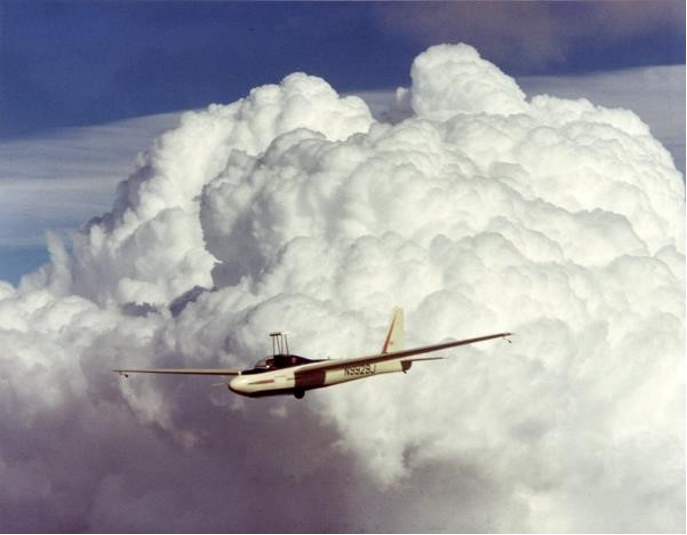NCAR Explorer Sailplane
NCAR Explorer Sailplane History and Scientific Discoveries
This website documents the chronological history of projects and events in which the Explorer Sailplane was used; many photos of the Explorer and descriptions and photos of instruments flown on the sailplane; and the highlights of many of the scientific discoveries made with the Explorer in the context of scientific understanding current during that era. The Sailplane was used for ground breaking cloud physics and cloud electrification research. The development of the Cannon cloud particle camera which continuously photographed water and ice particles inflight and the electric field mills developed by New Mexico Tech were especially valuable.
Overview of the Explorer Sailplane History and Accomplishments
A heavily instrumented sailplane, Explorer (aka the Explorer, the sailplane), was used for almost three decades from 1969 to 1995 by the Cloud Physics Program of the National Center for Atmospheric Research (NCAR) to investigate physical processes in growing cumulus congestus clouds as they developed precipitation, became electrified and grew into the beginning stages of thunderstorms. The measurements made by Explorer were unique because they were obtained as the sailplane ascended continuously in a spiral in the updrafts of the growing cloud systems rather than making penetrations horizontally across the cloud. In this quasi-Lagrangian manner the spiraling ascent allowed the study of the growth and evolution of particles, both water and ice, as parcels of air ascended in the clouds. The flights also allowed us to continuously measure the build-up of electric fields in growing clouds.
The development of reliable instruments for making critical measurements in this cold, heavily icing and sometimes highly electrified environment was an important aspect of the sailplane effort and contribution. Electronics and instruments developed for the sailplane of necessity had to be light weight with low power consumption since a battery was the only source of power. These studies took place in an era of rapidly evolving electronic and technological advances. Discoveries in the understanding of physical processes in clouds were often a result of the addition and development of new instruments. The research conducted with the sailplane occurred in a period of expanding scientific exploration and one in which substantial resources were available. The team of personnel associated with the sailplane development and operation included leading scientists and support scientists, innovative engineers and technical staff, a talented instrument-maker machinist, dedicated programmers and highly capable and adventuresome pilots.
This website presents the history of the development of Explorer as a research platform. The specialized on-board instruments, research projects, and the highlights of many of the scientific discoveries made by Explorer are covered. These are discussed in the context of scientific understanding current during that era. The development of the Cannon Cloud Particle Camera, which continuously photographed water and ice particles in-flight, was especially valuable.
Why a Sailplane for Cloud Physics Research
The sailplane had attributes that made it a unique platform for research to study the development of precipitation and early electrification in growing cumulus congestus clouds.
These include:
- It could ascend continuously in a spiral in the updraft of cumulus clouds to monitor particle formation, growth, and evolution, including ice formation, as the air parcel ascends and cools.
- Quantitative measurements of vertical air velocity can be made as the sailplane ascends/descends because the sailplane itself responds directly to the upward or downward moving air.
- The slower airspeed of 35 to 45 m/s gave better spatial resolution than powered aircraft. (e.g. The Queen Airs at NCAR and University of Wyoming flew at 75 to 95 m/s) The slower speed of the sailplane made measurement of some parameters such as temperature and particle size and concentrations easier to obtain.
- There was no contamination from engine exhaust or of hydrometeor particles thrown off propellers.
- The all-metal sailplane was resilient to lightning strikes and was “electrically quiet” for electric field measurements because there were no streams of charge coming from engine exhaust or off the propellor tips.
- The all-metal structure and aerodynamic shape were good for mounting instruments.
- It maintained stable flight characteristics even with substantial icing on the wings.
We highly recommend viewing the movie “Two Niner Juliet” produced in 1971 by the NCAR Communications Office. It gives an excellent overview of sailplane operations, photographs of early instrumentation and the research approach for both cumulus and wave cloud. See https://www.youtube.com/watch?v=DPBuxoW4y3U
Principal Investigator
James Dye
NCAR Senior Scientist Emeritus
dye@ucar.edu
Contributing Authors
James Dye
Daniel Breed
Theodore Cannon
Vim Toutenhoofd
Brian Heckman
Data Management
EOL Archive NCAR/EOL/DMS
